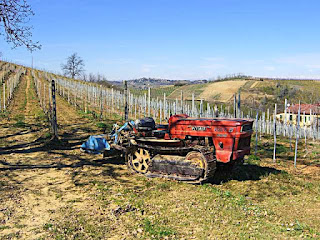 |
| Flooded Vineyards are a Problem |
There was a plan in our small Sonoma county garden. Organized nature, I think it was, with a tapestry of colors, shapes and textures that blend into one another over small spaces, seemingly isolated from one another. That was five(5) years ago, and we continue to move and re-plant, replace and mourn our garden losses. My curtain of vitis vinifera grape vines and our barrels of seedless vinifera table grapes over the same period have also never really reached our modest expectations. There would be overly vegetal growth with long, irregular canes and poor fruit-set; or when they had promise, like in 2010, my fruit would became a steady diet for local birds or raisin from a flash of summer heat. Chronically disappointed by these developments(or lack thereof), this new Spring is now following a dryer than normal, and again a mild winter, and I have come to the new philosophy that sometimes things just do not grow the way we want. We just need to grow with it!
 |
| Domestic Concord grapes |
What continues to grow are wine $ales. I remember hearing once that the 'American sweet tooth' was reflected by the commercial dominance of sweet wines in the domestic marketplace. With sweetened White Zinfandel, Boones Farm, Concord and other fruit wines prominent outside of dry-wine California, it seemed to make sense. It was also understood that an easy way to mask flaws in any wine is to add up to the allowable measure of sugar. But recent trends here are indicating that there are now newly discovered wines that have continued to add to the domestic power of sweet.
- Wine Business reports that sales of retail wine, off-premise segments below $20 and above $20 all showed significant growth in the four(4) weeks prior to early March. This continuing trend is supported in large part by the great growth of sweet red wines and the newly found popularity of white moscatos(Muscats).
- As impressive as that is, Wine Business has also reported that U.S. imports of Rose' wines from the Provence region of southern France grew at an astonishing 62% in volume in 2011 over the previous year!
- Continued domestic wine growth has currently been reported by the Wine Institute as well as Nielsen Company, citing the 18th consecutive year of volume growth for our industry. In addition, current numbers confirmed that U.S. wine drinkers are continuing to firmly be the World's largest wine consumers by overall volume.
- Western Farm Press noted that a 2011 survey of California nurseries showed a whopping 25%+ of all grape variety sales were for the Moscato vine. It is expected that plantings of Muscat grapes are to increase by as much as 136% by 2015!
 |
| Immature Moscato |
Perhaps the world's oldest domesticated variety, Muscat grapes(WINE STUDY:01/23/12) known by many synonyms are grown around the world, and as such are a thirst-quenching workhorse. They have evolved into a pretty large grape family. Uniquely, the variety has high concentrations of antioxidant flavonoids; about the amount found in many black skin grape varieties. It can produce dry wines in Spain or Alsace, semi-dry wines in Croatia(near its ancestral origins), or a sweet wine in the U.S. or Austria. Muscat is often fortified to arrest its fermentation or sun-dried to concentrate its sugars as with the VDN's of France or the passito wines of Italy, respectively. It even is the base for sparkling wines, most notably the Moscato d' Asti products of Asti Spumante made from the pressurized-tank Charmat method.
 |
| Moscato d'Asti Vineyards |
An azure blue bottle with a golden foil sat chilled recently on our dinner table. What could only be described as tropical aromas escaped even as I opened the bottle. A clear, golden straw tinted wine poured into the glass and what arose left impressions of stone fruits and warm Summer flowers. The La Sirena 2007 Napa Valley Moscato Azul enjoyed that evening was a rich, dry and balanced wine; described by my wife as being what could be only imagined as a papaya/ guava galette. Delicious, textured and flavorful, and it could not be mistaken for fresh. But, the evolution of this nectar was such that it filled and enriched our senses with its warm color, its complex aromas and its mouth-filling fruit character. This was one terrific food wine that added so much to our meal, and I had a moment where I understood its now growing varietal popularity.
 |
| Ripe Moscato |
From what has been reported by current wine trends and this reporters personal wine journey, Muscat or Moscato is in pretty good shape. Pricing, both imported and domestic, continues to reflect value, and selection seems poised to grow consistently in our marketplace. Sometimes we just need to grow with it. Now where did I put that bottle of dry Provencal Rose'?
Update: Wine Educator practical exam results should be coming out in the next few weeks, and I'll advise.
Salute!



